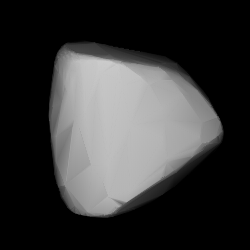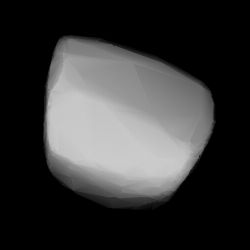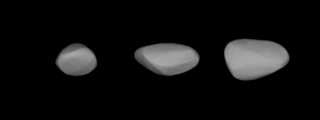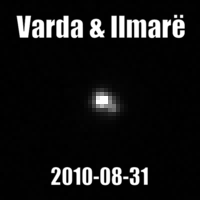
96 Aegle is a carbonaceous asteroid and the namesake of the Aegle family located in the outer regions of the asteroid belt, approximately 170 kilometers in diameter. It was discovered on 17 February 1868, by French astronomer Jérôme Coggia at the Marseille Observatory in southeastern France. The rare T-type asteroid has a rotation period of 13.8 hours and has been observed several times during occultation events. It was named after Aegle ("brightness"), one of the Hesperides from Greek mythology.

103 Hera is a moderately large main-belt asteroid with an orbital period of 4.44 years. It was discovered by Canadian-American astronomer James Craig Watson on September 7, 1868, and named after Hera, queen and fifth in power of the Olympian gods in Greek mythology. This is a stony S-type asteroid with a silicate surface composition.

105 Artemis is a main-belt asteroid that was discovered by J. C. Watson on September 16, 1868, at Ann Arbor, Michigan. It was named after Artemis, the goddess of the hunt, Moon, and crossways in Greek Mythology.

111 Ate is a main-belt asteroid discovered by the German-American astronomer C. H. F. Peters on August 14, 1870, and named after Ate, the goddess of mischief and destruction in Greek mythology. In the Tholen classification system, it is categorized as a carbonaceous C-type asteroid, while the Bus asteroid taxonomy system lists it as an Ch asteroid.

170 Maria is a Main belt asteroid that was discovered by French astronomer Henri Joseph Perrotin on January 10, 1877. Its orbit was computed by Antonio Abetti, and the asteroid was named after his sister, Maria. This is the namesake of the Maria asteroid family; one of the first asteroid families to be identified by Japanese astronomer Kiyotsugu Hirayama in 1918.

198 Ampella is a Main belt asteroid that was discovered by Alphonse Borrelly on June 13, 1879. The name seems to be the feminine form of Ampelos, a satyr and good friend of Dionysus in Greek mythology. It could also derive from the Ampelose, a variety of hamadryad. It is an S-type asteroid.

201 Penelope is a large main belt asteroid that was discovered by Austrian astronomer Johann Palisa on August 7, 1879, in Pola. The asteroid is named after Penelope, the wife of Odysseus in Homer's The Odyssey. It is orbiting the Sun at a distance of 2.68 AU with an eccentricity (ovalness) of 0.18 and a period of 4.381 years. The orbital plane is tilted at an angle of 5.8° to the plane of the ecliptic.

245 Vera is a large Main belt asteroid. It was discovered by N. R. Pogson on February 6, 1885, in Madras, and was named at the suggestion of his wife. The asteroid is orbiting the Sun at a distance of 3.11 AU with a period of 5.47 years and an eccentricity (ovalness) of 0.19. The orbital plane is tilted at an angle of 5.16° to the plane of the ecliptic. In 1890, Daniel Kirkwood noted that this asteroid shares similar orbital elements with 86 Semele and 106 Dione.

1578 Kirkwood, provisional designation 1951 AT, is a Hilda asteroid from the outermost regions of the asteroid belt, approximately 52 kilometers in diameter. It was discovered on 10 January 1951, by astronomers of the Indiana Asteroid Program at Goethe Link Observatory in Indiana, United States. The asteroid was named after American astronomer Daniel Kirkwood.
677 Aaltje is a main-belt minor planet orbiting the Sun, discovered by August Kopff at Heidelberg on January 18, 1909. It was named after the Dutch singer Aaltje Noordewier-Reddingius.
740 Cantabia is a minor planet orbiting the Sun. It was discovered on 10 February 1913 at Winchester, Massachusetts by American amateur astronomer J. H. Metcalf. Cantabia is a contraction of Cantabrigia, Latin for Cambridge, named in honor of Cambridge, Massachusetts. It is orbiting at a distance of 3.05 AU with a period of 5.33 years and an eccentricity (ovalness) of 0.11. Between 2014 and 2021, 740 Cantabia has been observed to occult three stars.

787 Moskva is a minor planet orbiting the Sun. It is a dynamic member of the Maria asteroid family orbiting near the 3:1 Kirkwood gap. This is an S-type (stony) asteroid spanning 27 km. The surface mineralogy is consistent with mesosiderite silicates.
914 Palisana, provisional designation 1919 FN, is a Phocaean asteroid from the inner regions of the asteroid belt, approximately 77 kilometers in diameter. It was discovered by German astronomer Max Wolf at Heidelberg Observatory on 4 July 1919.
1143 Odysseus, provisional designation 1930 BH, is a large Jupiter trojan located in the Greek camp of Jupiter's orbit. It was discovered on 28 January 1930, by German astronomer Karl Reinmuth at the Heidelberg Observatory in southwest Germany, and later named after Odysseus, the legendary hero from Greek mythology. The dark D-type asteroid has a rotation period of 10.1 hours. With a diameter of approximately 125 kilometers, it is among the 10 largest Jovian trojans.
1065 Amundsenia, provisional designation 1926 PD, is a stony asteroid and sizeable Mars-crosser on an eccentric orbit from the inner asteroid belt, approximately 10 kilometers in diameter. It was discovered on 4 August 1926, by Soviet astronomer Sergey Belyavsky at the Simeiz Observatory on the Crimean peninsula. The asteroid was named after Norwegian polar explorer Roald Amundsen.

174567 Varda (provisional designation 2003 MW12) is a binary trans-Neptunian planetoid of the resonant hot classical population of the Kuiper belt, located in the outermost region of the Solar System. Its moon, Ilmarë, was discovered in 2009.
4029 Bridges, provisional designation 1982 KC1, is a stony asteroid and binary system from the middle regions of the asteroid belt, approximately 8 kilometers in diameter.
1574 Meyer, provisional designation 1949 FD, is a carbonaceous asteroid from the outer region of the asteroid belt, approximately 59 kilometers in diameter. It was discovered on 22 March 1949, by French astronomer Louis Boyer at Algiers Observatory in Algeria, northern Africa. It was named after French astronomer M. Georges Meyer.
6244 Okamoto, provisional designation 1990 QF, is a background asteroid and binary system from the inner regions of the asteroid belt, approximately 5 kilometers in diameter. It was discovered on 20 August 1990, by Japanese astronomer Tsutomu Seki at the Geisei Observatory in Kōchi, Japan, and later named after Japanese school teacher Hiroshi Okamoto. The presumed S-type asteroid has a short rotation period of 2.9 hours. The discovery of its minor-planet moon was announced in October 2006.
3402 Wisdom, provisional designation 1981 PB, is a stony asteroid and Mars-crosser on an eccentric orbit from the inner regions of the asteroid belt, approximately 2.5 kilometers in diameter. It was discovered on 5 August 1981, by American astronomer Edward Bowell at Lowell's Anderson Mesa Station near Flagstaff, Arizona, in the United States. The presumed bright S-type asteroid has a rotation period of 4.99 hours. It was named after American planetary scientist Jack Wisdom.











